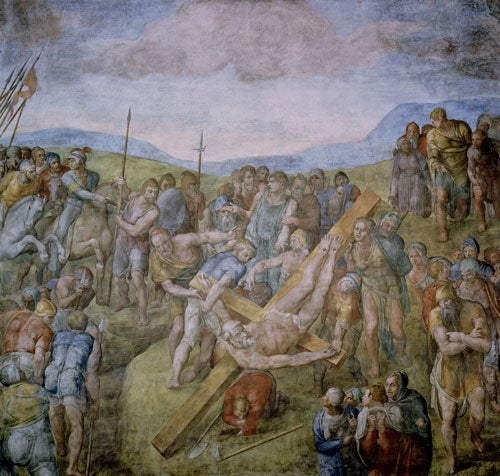Vatican allows St Peter's 'black spots' to remain
Nails added to Michelangelo fresco will not be removed

No wonder St Peter looks so annoyed. When Michelangelo created this masterpiece in the Pope's private chapel in 1550, the saint wasn't pinioned to the cross by three ugly black nails – described by one expert as "cockroaches". Now, after a holy row following the five-year restoration which revealed the intruding black spots, the Vatican has decreed they should stay.
According to one member of the expert commission which advised on the £2.7m cleaning project, Pope Benedict himself was involved in the final decision. "The commission decided that the Holy Father would have the last word," the German art historian Christoph Luitpold Frommel said. "I'm hopeful the pontiff will say that Michelangelo is too important for his interpretation to be modified."
It is a row which pits art against history and theology. Michelangelo had intended The Crucifixion of St Peter, his final painting, to depict the foremost Apostle and first Pope to be volunteering for martyrdom – hence no nails. He was also originally naked.
At some point in the intervening 450 years or so, another artist added the nails and the cloth around the saint's midriff, the Vatican's chief restorer, Maurizio de Luca, said.
"It is impossible to know when because the pigments are the same," he said. "My opinion is that the nails were added around 100 years ago, which is quite recent. But I don't know if that person had a memory of something that was first put there in the 17th century." The wrap is believed to have been painted on the orders of Gregory XIII, who was Pope from 1572-85. "Popes might not want such a large completely naked man in the chapel," Professor Frommel said. "The nails, however, are very serious. They look like cockroaches."
William Wallace, an expert on Michelangelo and professor of art at Washington University in St Louis, Missouri, said that the history of the painting should be respected. "To me the nails are part of the history of the painting," he said. "This is the history of Christianity. The purity of what Michelangelo intended is not the most important thing."
The Crucifixion of St Peter was commissioned by Pope Paul III in 1542 for the private Pauline Chapel, next door to the Sistine Chapel. It was finished in 1550 when the artist was 75.
"Whether you keep them or not, you are still being highly respectful to the subject matter," Professor Wallace added. "It is not unusual for works of art from the Renaissance to have some kind of intervention over time, whether it's cleaning, or refixing the lining."
Mr De Luca said yesterday, however, that the Vatican had decided to keep the nails. "The nails were the preference of the church over the centuries and part of the history of the work of art," he said. "Someone thought 'why should Peter not have nails?', although Michelangelo perhaps intended to realise the exact moment when St Peter offered himself on the cross."
Join our commenting forum
Join thought-provoking conversations, follow other Independent readers and see their replies
Comments
Bookmark popover
Removed from bookmarks